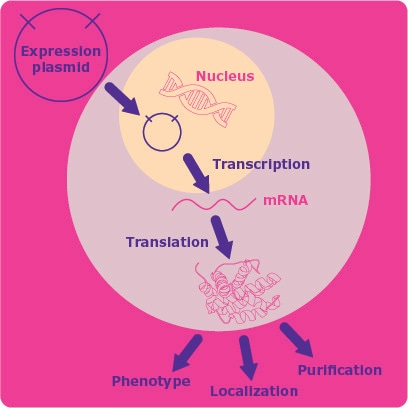Molecular Cloning & Protein Expression

The aim of molecular cloning is to insert the gene-of-interest (GOI) into a plasmid vector, a circular piece of DNA that contains various elements to facilitate cloning, clone selection, and protein expression. Researchers often use DNA restriction enzymes and ligase to insert the GOI in-frame within the expression vector for subsequent protein expression. This vector is then inserted into a cell that will express the protein encoded by the GOI or protein expression is accomplished using cell-free protein synthesis systems.
Once the protein is expressed, the protein function can be studied as it affects the cell signaling, morphology, or other aspects within the cell. Alternatively, the protein can be expressed in large quantities, purified, and used in numerous downstream applications. For additional information, explore our comprehensive offering of reliable reagents and resources that are available across the cloning & expression workflow for insect, bacteria, and mammalian protein expression systems.
Products
Restriction Enzymes and DNA Modifying Enzymes
In molecular cloning, researchers often use two general types of enzymes – restriction enzymes for cutting DNA and modifying enzymes for making nucleic acid modifications, often before the ligation step. Explore our wide range of restriction enzymes and other modifying enzymes such as Alkaline Phosphatase, Protease, T7 RNA polymerase, Ribonuclease A and T4 DNA ligase for all your research needs.
Cell-Free Expression Systems and Expression Vectors using CMV Promoters and FLAG® Tag Technology
Our cloning and expression portfolio make genetic engineering cheaper and more efficient by providing a collection of versatile vectors with streamlined protocols and cloning kits. Choose from our wide range of cloning & expression systems, including our Cell-Free Protein Synthesis or Expression system, such as the Next Generation Cell-Free Protein Expression Kit (Wheat Germ) and the ALiCE® kit. Additionally, discover the bacterial and mammalian FLAG® expression vectors for periplasmic or cytoplasmic expression in transient or stable transfection systems and confidently express your FLAG® or 3X FLAG® sequence on the N- or C-terminal with an enterokinase (Ek) cleavage site to remove the fusion tag if necessary.
Novagen® pET System, SnapFast™ Vectors, Simplicon™ Vectors, and UCOE™ Protein Expression Systems
All E. coli expression vectors and insect expression vectors confer ampicillin resistance for easy selection of positive transformants. Discover the Novagen® pET System, the gold standard for cloning and expression of recombinant proteins in bacterial expression. Engineered by Oxford Genetics, the SnapFast™ family of vectors offers a quick and easy protocol allowing the transfer of a GOI from one vector to another using the SnapFast™ cutting sites, generating vectors which are compatible with insect, yeast, bacterial & mammalian expression systems. With our Ubiquitous Chromatin Opening Element (UCOE™) expression vector technology, you can achieve grams of protein in less than 30 days in stably-transfected mammalian cells. UCOE™ expression technology prevents transgene silencing and gives consistent, stable and high-level gene expression, up to 20-fold higher than conventional vectors, irrespective of the chromosomal integration site. The Simplicon™ In Vivo Protein Expression System is a non-genome integrating, tunable, and synthetic self-replicating RNA-based expression system that generates immediate, high-sustained protein expression of multiple genes into transfected human cells without the risk of genome integration..
Bacterial and Yeast Transformation Reagents and Resources
Bacterial transformation is the process of inserting foreign DNA into bacteria using methods such as heat shock and electroporation. Our portfolio of competent cells is engineered for optimal protein expression for even the most challenging recombinant proteins. Browse our Competent Cell Selection Guide to choose from a variety of new bacterial competent cells for a wide variety of applications, including protein expression, routine or difficult cloning, and library generation. Additionally, recombinant protein expression in Saccharomyces cerevisiae has many advantages, such as simple protocols, use of basic reagents, and scalability. Explore the many products available for yeast transformation as part of the protein expression workflow. Our NovaBlue® competent cells, optimized for transfection efficiency and plasmid preservation, support superior library preparations and plasmid stability. Additionally, the Novagen® competent cells are designed to facilitate proper protein folding, increased solubility or expression of cytotoxic proteins. The most popular brands being Rosetta™, Origami™ and Overnight Express™ systems.
Related Resources
- Brochure: Molecular Essentials Guide
Learn how our comprehensive molecular tools and reagents provide precise, ready-to-use solutions for your workflows.
- Article: Cell-Free Protein Synthesis or Expression
Cell-free protein synthesis rapidly produces recombinant proteins without cells, utilizing translation machinery from different cell types for efficiency.
- Article: Competent Cell Selection & E. coli Markers Guide
Select competent cells by application, transformation efficiency, and genotype. We also present a list of E. coli markers for reference.
- Article: Simplicon™ in vivo Protein Expression System
Simplicon: A non-genome integrating, tunable and sustained protein expression system in human cells, based on a single, polycistronic, and self-replicating synthetic RNA.
To continue reading please sign in or create an account.
Don't Have An Account?